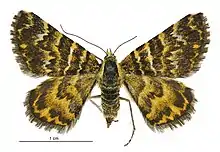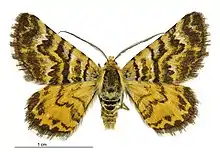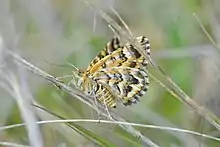Notoreas elegans
Notoreas elegans is a species of moth in the family Geometridae, endemic to New Zealand. This species has a wide distribution in New Zealand and is therefore regarded as not being in need of conservation.
| Notoreas elegans | |
|---|---|
 | |
| Female | |
 | |
| Male | |
| Scientific classification | |
| Domain: | Eukaryota |
| Kingdom: | Animalia |
| Phylum: | Arthropoda |
| Class: | Insecta |
| Order: | Lepidoptera |
| Family: | Geometridae |
| Genus: | Notoreas |
| Species: | N. elegans |
| Binomial name | |
| Notoreas elegans | |
Taxonomy and etymology
This species was first described in 2010 by Brian Patrick and Robert J.B. Hoare.[2] The epithet elegans means elegant and was used to honour the attractive colouration and pattern on the wings of the adult moth.[2]
Description


When mature N. elegans larvae have a brown head, a bright green body with a band on its dorsal side coloured white with pink and yellow hints.[2] The subdorsal portion of the larvae has some white shading and there is also a lateral band of pale white pink.
Adult moths of this species have bright orange and white markings on their forewings with orange and black-marked hindwings.[2] N. elegans is similar in appearance to its close relations N. edwardsi and N. casanova.[2]
Distribution
This species is endemic to New Zealand.[1] N. elegans occurs at elevations of between 150 and 1900 metres in the valleys and alpine areas of the Mackenzie Basin, South Canterbury, Otago and Fiordland.[2]
Life cycle and behaviour
This species normally produces two broods per year but it has been hypothesised that at some localities it may produce only once in a season.[2] The female moth lays her eggs within the flower buds of their host plant.[3] When the larvae emerge from their eggs, they eat into the leaves or buds of their host, hiding from predators.[3] Once they are large enough, they emerge to feed from the fresh growth of the plant.[3] N. elegans pupate in a loose cocoon on the ground under their host.[3] The species spends approximately 43 days in their cocoon before emerging as an adult.[2] N. elegans are day flying moths.[3] They are low but fast flyers and constantly vibrate their wings to enable them to take off rapidly.[3]
Host species
The host plants for the larvae of N. elegants are endemic species within the genus Pimelea.[2][4] These include Pimelea aridula, Pimelea oreophila, Pimelea pseudolyallii, Pimelea sericeovillosa and Pimelea traversii.[4]
Conservation status
This species has a wide distribution in New Zealand and is therefore regarded as not being in need of conservation.[2]
References
- "Notoreas elegans Patrick & Hoare, 2010". www.nzor.org.nz. Manaaki Whenua - Landcare Research.
- Patrick, BH; Hoare, RJB; Rhode, BE (2010). "Taxonomy and conservation of allopatric moth populations: a revisionary study of the Notoreas perornata Walker complex (Lepidoptera: Geometridae: Larentiinae), with special reference to southern New Zealand". New Zealand Journal of Zoology. 37 (4): 257–283. doi:10.1080/03014223.2010.511127.
- Patrick, Brian (Autumn 2015). "Discovering New Zealand's gorgeous moths" (PDF). Butterflies and Moths of New Zealand. No. 12. New Zealand: Butterflies and Moths of New Zealand Trust. p. 13.
- "PlantSynz - Invertebrate herbivore biodiversity assessment". plant-synz.landcareresearch.co.nz. Manaaki Whenua - Landcare Research. Report generated when site is accessed.